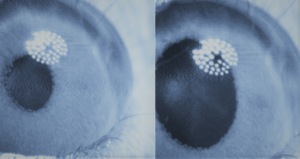The discovery opens the way to the development of safer and more effective therapies aimed at adrenergic receptors, such as ophthalmological procedures.

Is it possible to dilate pupils using light? The answer would be no, since they are designed to adjust to the intensity of ambient light, precisely in the opposite direction. This is why, for a commonly performed test by ophthalmologists to examine the optic nerve and the retina, it is necessary to dilate the pupil with drugs, called the mydriatic agents. Unfortunately, these dilation procedures present adverse side effects such as blurred vision, increased sensitivity to light, and increased eye pressure.
Now, researchers from the ‘Nanoprobes and Nanoswitches’ group of the Institute for Bioingeniería of Catalunya (IBEC), and the CIBER-BBN, led by research professor ICREA Pau Gorostiza, in collaboration with other research institutes (UAH, EHU, UAB, IRYCIS, IDIBAPS, IRB), have found an innovative alternative. In a study published in the journal Angewandte Chemie International Edition, researchers have shown that adrenergic receptors or adrenoreceptors can be “switched on and off” using light and a set of new molecules developed in IBEC.
Researchers called these innovative molecules “adrenoswitches”, or “adrenergic switches”. To demonstrate the effect of these molecular switches, researchers focused on an organ that offers a perfect window to light: the eye. One way to induce the dilation of the pupil is to use agonists of the adrenocetors, proteins that are expressed in almost any organ and tissue of the human body and that regulate also important physiological functions such as heart and respiratory frequency, digestion, vascular tone, pupil diameter and secretion of glands.
“Adrenoswitches” or adrenergic switches, innovative molecules tested in vivo
Using unconventional analogs of a photosensitive molecule called azobenzene, researchers designed the new compounds. They demonstrated, first, that these “adrenoswitches” are capable, under the right conditions of illumination, of dilating blood vessels in rats (antihypertensive effect) and reducing mobility in zebrafish (sedative effect).
The difference between commercialized molecules and the new “adrenoswitches” is that the latter are inactive in the dark, while illumination with violet light activates their action, so that their use can be better controlled. Eye dilators (mydrial agents) commonly used in various ophthalmic procedures have side effects. This is why the pharmaceutical industry is looking for new drugs that can disable their action after eye scanning. In contrast, researchers at IBEC envisioned a drug that would dilate the pupil only during the exam, and then de-activate, as soon as the light is gone.

Figure: The degree of dilation of the pupil is regulated by α-adrenoceptors located in the dilator muscle of the iris. Exposure to intense light induces spontaneous contraction of the pupil as a reflex mechanism to protect the retina. Adrenoswitch-1, a photochromic agonist α-adrenergetic, causes a response in blind mice after activation with violet light (B). In wild animals, the compound inhibited the pupillary reflex caused by violet (purple line), while the response to visible light remained (green line) (C) Source: Angewandte Chemie International Edition, 2020.
The molecules that we have developed, called Adrenoswitches, could be a disruptive tool to selectively activate physiological processes with a beam of light, and develop safe and effective therapies.
Davia Prischich. IBEC investigator and principal author of the article.
When tested in blind mice, whose pupils do not respond to illumination, the adrenoswitch-1 molecule triggered a pupil dilation which reversed when removing the light source. In wild animals, it inhibited the contraction reflex of the pupil by activating it with violet light. This finding is expected to allow extensive fundamental and therapeutic applications, as it combines the selectivity of pharmacological modulation with the precise properties of light.
Reference article:
Davia Prischich, Alexandre M. J. Gomila, Santiago Milla-Navarro, Gemma Sangüesa, Rebeca Diez-Alarcia, Beatrice Preda, Carlo Matera, Montserrat Batlle, Laura Ramírez, Ernest Giralt, Jordi Hernando, Eduard Guasch, J. Javier Meana, Pedro de la Villa, Pau Gorostiza.Adrenergic modulation with photochromic ligands. Angewandte Chemie, International Edition. 2020.





